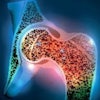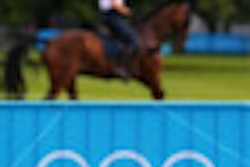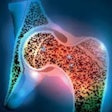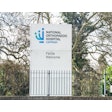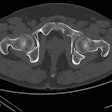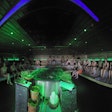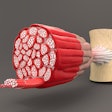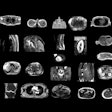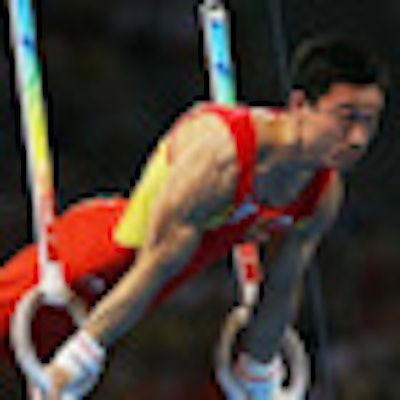
When the doors of London 2012's Olympic polyclinic open to athletes for the first time next week, the chances are that Finn Crotty will be close on hand. As GE Healthcare's head of Olympic delivery, he's responsible for the installation of a wide range of imaging equipment on a tricky site in a congested part of the city. He's lived and breathed the complex project since his appointment last March, and has built up an intimate knowledge of the polyclinic.
"During the installation period, it's been really tough getting bodies and vehicles and parts onsite, but during games time, it's going to be two- or threefold harder," he said. "Around London, there'll be a much greater volume of people and getting parts here and ensuring maximum uptime of the equipment will be a challenge."
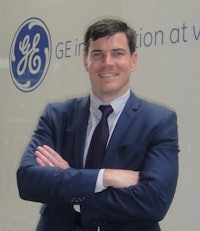 "There's never been a moment when I've wanted to lock myself up in a dark room and scream," Finn Crotty said.
"There's never been a moment when I've wanted to lock myself up in a dark room and scream," Finn Crotty said.
Along with the London Organizing Committee of the Olympic and Paralympic Games (LOCOG) project manager for the polyclinic, he has had to deal with multiple contractors. Finalizing the equipment specifications, meeting all the siting requirements, and coordinating the onsite training have all posed challenges, but the tasks have proved manageable.
"I'm a very positive person, and there's never been a moment when I've wanted to lock myself up in a dark room and scream," he explained. "Every now and then you realize the enormity of the project responsibility and the high-profile nature of the event. You might wonder 'What if an MRI quenches?' but that's not the sort of thing you can cater for, and you just have to get on with managing what you can control."
Crotty's been with GE for nearly 10 years, working as a radiology account manager in southeast England for five years before his current appointment. He originates from near Brisbane, Australia, and has neither a clinical nor a technical background, having worked his way up through sales.
"The work here really started to ramp up from around September," he said. "We have specified high-end kit for a sports injury clinic because it's the Olympics and we want to showcase the latest and greatest of our technology."
A major logistical challenge has been what Crotty refers to as "relocatables" -- the temporary structures that house the two MR units and one CT system. These are located immediately opposite the main entrance, and are necessary because after the games the polyclinic will be converted into a primary care center that will not require MRI or CT. The adjacent railway line and the traffic from the nearby roads meant that extensive testing had to be carried out during May.
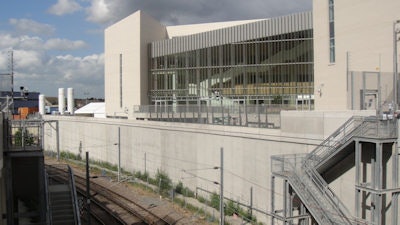 The four-story, 5,000-sq-meter polyclinic was built alongside a busy railway line, and this meant special protective measures needed to be taken to stabilize the MRI and CT scanners.
The four-story, 5,000-sq-meter polyclinic was built alongside a busy railway line, and this meant special protective measures needed to be taken to stabilize the MRI and CT scanners.One of the many uncertainties about imaging of the Olympics is how much the CT will be used and for what purposes. At the Beijing Olympics in 2008, CT was not available onsite so there are no recent precedents here.
"There's always a concern that these are healthy people getting radiation," he noted. "We need to be at a point where very low doses are given so that CT can then become one of the tools in a clinical tool set."
The radiation dose will be worked out precisely according to each patient's body weight and the area under investigation. The Discovery 750HD CT scanner has been fitted with an automatic exposure control system, called AutomA. A noise index parameter allows a radiographer to select the amount of x-ray noise that will be present in the reconstructed images. Using a single patient scout exposure, the CT unit computes the required mA to be used based on the selected noise index setting.
CT may be used more extensively during the Paralympics, which will take place in the same location from 29 August to 9 September. Many of these competitors are likely to have metallic implants and devices of unknown origin, making them inappropriate for MRI.
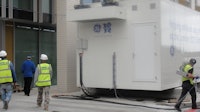 The Discovery MR750w wide-bore 3-tesla MRI system is located immediately opposite the main entrance to the polyclinic in a temporary structure resting on huge concrete plinths.
The Discovery MR750w wide-bore 3-tesla MRI system is located immediately opposite the main entrance to the polyclinic in a temporary structure resting on huge concrete plinths.
All athletes should fit safely into the machine, though it may be a squeeze for some of them. The bore of the CT unit is 70 cm, which can accommodate athletes up to 250 kg. "That's a lot of weight lifter -- in fact, a lot of anyone!" Crotty joked.
All visitors must report to reception whether or not they have made an appointment, and in most cases they'll be accompanied by a team doctor. About half of patients are likely to have booked an appointment, whereas the other half will be walk-ins. The first step for most patients is to see a sports medicine doctor.
The Discovery XR656 wireless digital x-ray system is likely to be the polyclinic's front-line investigation tool, particularly given the speed of an examination. It will take around five minutes to scan a patient. During the Olympics, a team of 17 volunteer radiographers will be shared between CT and x-ray.
Two Logic E9 ultrasound machines, plus a Venue 40 system, are located in the polyclinic. Another E9 unit will be at Royal Holloway, University of London, where the rowing and canoe events are to take place. A further machine will be at Weymouth, Dorset, for the sailing. Radiologists will perform the musculoskeletal (MSK) scanning, while a team of five sonographers will carry out obstetrics and gynecology examinations.
"The MSK ultrasound work is going to be huge. Along with MRI, these are going to be busiest of all our products," he predicted.
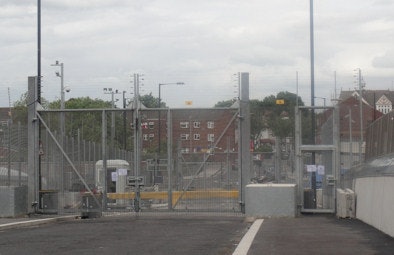 Security is already extremely tight at the Olympic Village, as shown by this photo of an entrance next to the polyclinic.
Security is already extremely tight at the Olympic Village, as shown by this photo of an entrance next to the polyclinic.All staff will receive training on the RIS. A Centricity RIS/PACS is being used to manage all the images and data, enabling clinicians to access complete electronic patient records. The two PACS reporting workstations and an Advantage Windows workstation have been integrated with the RIS. In addition, a CD production unit will allow athletes to take their images and reports home on CD after the games.
Crotty described the RIS/PACS as the glue that binds together the whole operation, and noted that the system is an integration of two products, the Centricity RIS and WEB PACS. The latter is a medical software system for viewing and storage of medical images and other information. It allows multiple users to remotely access the images it stores, from compatible computers on a network for the purpose of manipulation, diagnostic interpretation, and postdiagnostic review of the images and the other objects it stores. The RIS/PACS is designed to enable radiologists to access clinical images remotely in seconds.
About 200 athletes will be treated daily in the main polyclinic, which will be used by up to 16,000 Olympic athletes and team officials and 6,200 Paralympic athletes and team officials. The polyclinic will operate 24 hours a day from 16 July, when the Olympic Village opens, to 15 August, and from 22 August to 12 September for the Paralympics. It will be open daily from 7 a.m. until 11 p.m. An out-of-hours service will run via the emergency department.
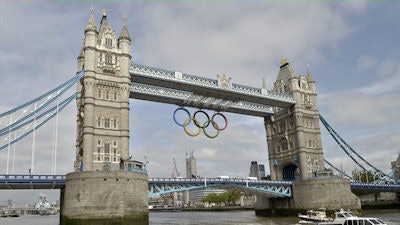 London is all set for the start of the Olympics on 27 July. Giant rings weighing more than 3,000 kg and measuring more than 25 meters wide by 11.5 meters tall, hang from Tower Bridge. During the games, each of London's famous bridges will be lit up in the evenings. Image courtesy of London 2012.
London is all set for the start of the Olympics on 27 July. Giant rings weighing more than 3,000 kg and measuring more than 25 meters wide by 11.5 meters tall, hang from Tower Bridge. During the games, each of London's famous bridges will be lit up in the evenings. Image courtesy of London 2012.The plan is for the imaging equipment to be sold or redeployed within the U.K. National Health Service (NHS), and Crotty expects to be onsite at the Olympic Village until the end of October.
"I've been coming in and out of here for weeks and months, but I'm still trying to visualize what it will be like here on, say, the second of August, when the competition starts to heat up. Will there be throngs of people coming in and out of the place?" he asked.
Crotty hasn't got long to wait until this question and others are answered. Soon the polyclinic will be open for business.


